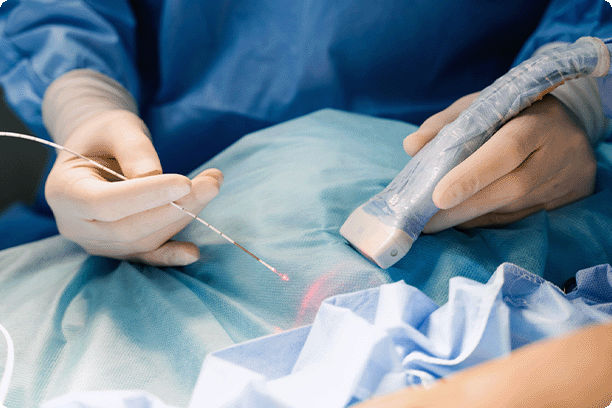Veinlite Sclerotherapy

At a Glance
Veinlite-guided sclerotherapy allows the physician to see veins below the skin’s surface, even those that may not be visible to the human eye. This procedure is indicated for superficial spider veins and feeder vessels.
Desired results may take up to two months to fully appear. Risks and side effects for this procedure are rare.
The Procedure
Veinlite-guided sclerotherapy is a minimally-invasive form of sclerotherapy in which the Veinlite guides the physician to the source of superficial spiders. The Veinlite transilluminates veins below the skin, even vessels that may not be visible to the human eye, allowing Dr. Hyde to accurately map out the course of feeder vessels before injecting the spider veins. Feeder vessels are typically blue-green in color and are called reticular veins. Some feeder vessels can originate 4-8 inches away from where the spider is presented on the surface. Locating and closing all feeder vessels is critical to treating spider veins and ensuring they do not recur.
Like ultrasound-guided sclerotherapy, Veinlite sclerotherapy allows the physician to more accurately assess the damaged veins and inject the solution into the right place to close the vein. However, Veinlite sclerotherapy is used for surface feeder vessels instead of deeper sources of reflux.
What Conditions Does It Treat?
Veinlite-guided sclerotherapy provides accurate treatment for superficial spider veins and their feeder vessels. Since it cannot see deep beneath the surface, it is not indicated for treating spiders resulting from deep feeder vessels.
Am I a Candidate?
Veinlite-guided sclerotherapy is indicated when patients have superficial spider veins with feeder vessels near the skin surface. Patience is essential during the course of treatment, as desired results for sclerotherapy patients can take approximately two months to become apparent.
At first, the injected vein may begin to look darker than it did initially, but this darkness typically fades within a week. Veinlite-guided sclerotherapy, like other forms of sclerotherapy, may involve many sessions depending on the severity of your vein problems.
Recovery
Recovery for Veinlite guided sclerotherapy is much the same as conventional sclerotherapy. Patients can typically move about directly after the procedure and return to regular activity after 24 hours. Compression bandages or stockings will be employed to aid in circulation. A short period of elevation may be required, but afterward, the patient should use regular walks and exercise to help promote vascular flow and prevent blood clots in untreated veins.
Blood clots and scabs will form on the inside of the treated vein due to the procedure. As a result, lumps may begin to appear under the skin. The lumps should fade as your body breaks down the scabs. You may experience discoloration or tenderness as the scabs heal.
Potential Risks
Complications are minimal when an experienced vein specialist performs Veinlite-guided sclerotherapy. Risks include those associated with conventional sclerotherapy, which are discoloration of the vein under the skin, bruising or inflammation at the injection site, and allergic reactions from ingredients in the solution.
Matting can also occur, where your body forms many tiny blood vessels around the injection site. Matting will usually resolve independently but sometimes requires additional injections to relieve.

Request a Consultation
To request an Veinlite Sclerotherapy consultation, fill out the form below or call us!
Walnut Creek 925-937-8346 |
